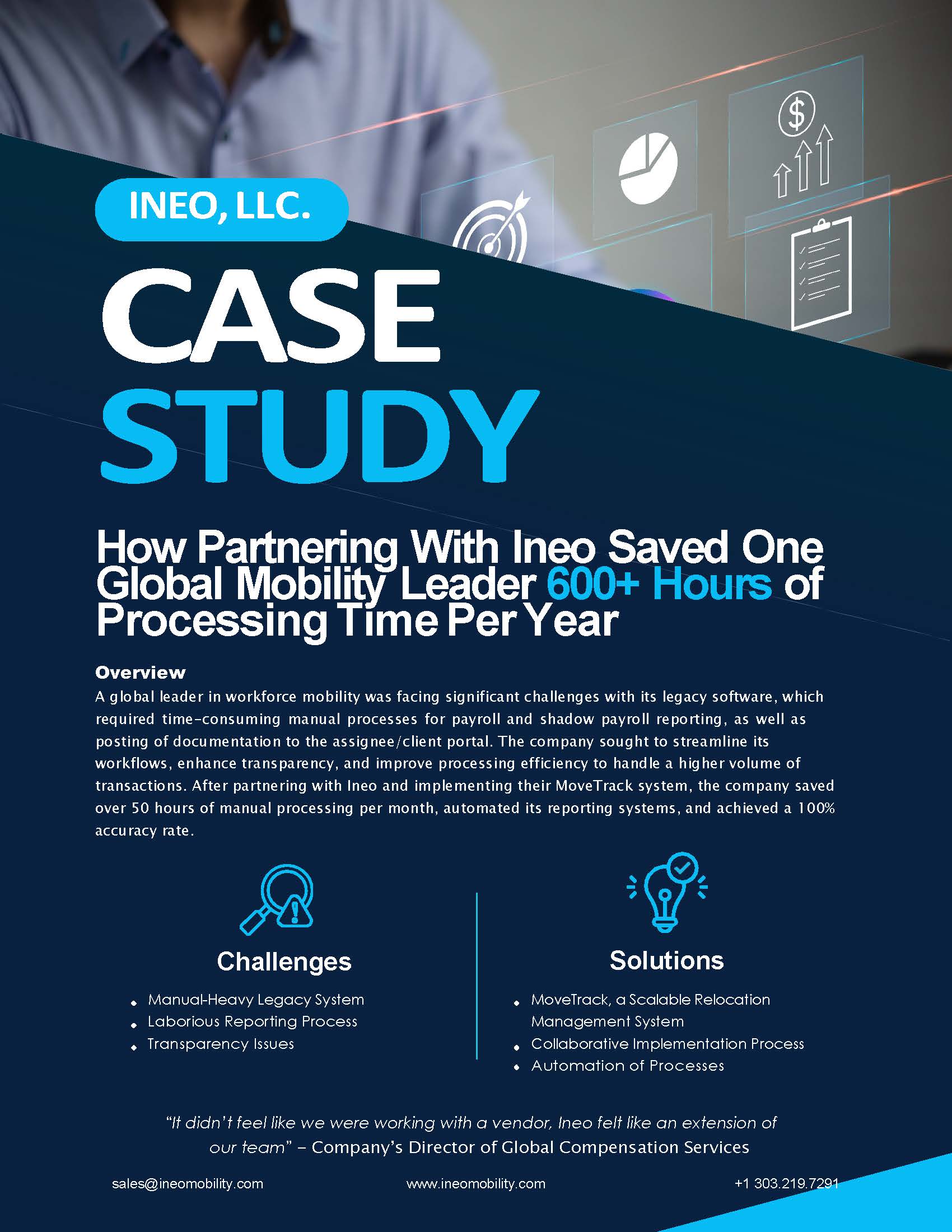Could COLA be the Make or Break for your Global Mobility Program Success?

Is it time to add a COLA to corporate relocation packages?
Inflation has been ticking steadily up for well over a year. Compounding the problem are lagging impacts of the pandemic to our supply chain, a war in the Ukraine that spiked global prices of crude oil, and a persistent and deadly outbreak of avian flu that has skyrocketed the cost of eggs.
To keep it from growing unchecked and wreaking wider havoc on the U.S. and global economy, the Federal Reserve Board has instituted interest rate increases, pushing it to the highest it’s been in 15 years. While it’s true that inflation has recently shown signs of cooling after the recent interest rate hikes, it doesn’t mean that the cost of living for the average American has seen a significant turn upwards.
All of that is to say that inflation, and the Fed’s response, are having a dramatic effect on the economy, as well as how companies react to them. From layoffs to missed earnings reports on Wall Street, few are immune to the effects of inflationary pressure on the cost of living.
The simple fact is, it’s fast time to start talking about adding COLA to your corporate relocation packages. Your ability to attract, retain and relocate top talent depends upon it.
But first, let’s review some of the aspects of COLA and then move on to how you should consider baking a COLA into your corporate relocation program.
COLA explained
The cost of living literally refers to the amount of money it takes to cover living expenses in a given location.
COLA, on the other hand, refers to cost-of-living adjustment, which came into being in 1975 when the inflation rate was over 9%. The Social Security Administration implemented what it called the “Cost-of-Living Adjustment” in order to offset the effects of inflation on the purchasing power of retirees dependent on social security payments.
In the corporate world, COLA is used by companies to increase an employee’s compensation package when they are asked to relocate to an office with an appreciably higher cost of living. A COLA may be paid in lump-sum or as installments over a defined period of time to help soften the financial impact of moving to a more expensive location.
Not sure how much of an impact a change in cities can have on an employee’s cost of living? Take the example of an employee moving from Nashville to San Francisco. If that employee makes $50,000 in Nashville, they will have to make $96,520 to match the purchasing power of their current salary. That’s a whopping 93% difference between the two locations. The Nashville native will pay more for everything from pizza and haircuts to gym memberships and dental visits. Once an employee does the math on the cost-of-living disparity, it could quickly sour their initial excitement about moving to the Bay Area.
The COLA Calculation
Many companies with offices in major metropolitan areas like NYC, San Francisco, or Boston are already familiar with the need for some kind of COLA to incentivize employees and help them make ends meet. But not all companies have this experience, and many are being confronted with the need for a COLA at least in part because of the impact of inflation and rising interest rates. If you want to move an employee from Manhattan, Kansas to Manhattan in the Big Apple, be ready to increase their salary and offset living expenses that are 165% higher.
When calculating COLA for employee relocations, it is important to consider how often you are moving employees. If your relocation volume is relatively low, then it might make sense to calculate COLA on your own. However, if you have a large number of relocations with offices spread around the U.S. and beyond, then it might make sense to outsource at least some of the heavy lifting to a third-party resource.
To calculate your own COLAs, you need to figure out which locations will need to be measured. For instance, if you have office locations in a dozen cities across the U.S. and Canada, then make a list of the office addresses to use for determining your cost-of-living index (COLI) for each location.
How do you go about determining a COLI? They are not typically easy to find, let alone calculate, in part because finding the data on so many of the index’s goods and services in communities across the U.S. requires a continuous and significant amount of research effort. As such, it’s far easier if you enlist the help of a third party that specializes in collecting and weighing pricing data on the six major expense categories. One such organization that tracks the COLI is C2ER, which pulls data on over 60 goods and services collected at the local level from over 300 independent researchers across the country to calculate its COLI.
There are also cost of living calculators all over the Internet these days. They can come in handy for a fast, easy comparison of cities but are a step removed from a more primary source of insights on COLI like those from C2ER and other respected third-party providers.
In case you’re wondering exactly what goods and services go into making up the economic basket that becomes a COLI for a given community, here are the six main categories used:
Housing: whether as monthly rent or a mortgage payment, housing costs comprise the largest portion of expenses Americans spend to live in a given community. Home ownership also includes related costs such as property taxes, insurance, and community fees.
Food: another large component of a COLI is the cost of food. This mostly refers to grocery items and excludes the cost of dining out. Even still, it’s the second largest portion of the COLI and as such can greatly influence the index differences between cities.
Utilities: don’t count out the cost of utilities as they help heat, cool and generally make your home livable. Plus, their cost can vary dramatically depending on which state and community you live in.
Transportation: just like it sounds, transportation includes everything that helps you get from point A to point B: cars, taxis, buses, airlines, subways, etc. Because most Americans own cars, car expenses are a big piece of the transportation pie and include the cost of gas at the pump, maintenance, auto loans, tolls, parking, and more.
Healthcare: it may not be the largest category of expenses in the COLI calculation, but the cost of healthcare adds up fast, especially for families.
Miscellaneous Goods and Services: this is a grab-bag of expenses that Americans pay for in their day-to-day lives. Not surprisingly, in the aggregate, this category accounts for the second largest bucket of expenses Americans put their hard-earned incomes toward. Expenses you might find here include entertainment, clothing, dry cleaners, champagne brunches, beach trips, and much more.
To calculate or not to calculate COLA and COLI
Every company must face the age-old question of whether to handle a function with internal resources or seek the help of an outside party. For some companies, it may make sense to spend the time and money to obtain the necessary data on COLI for each potential location and then run the calculations. For others, it makes sense to bring in a third-party expert to take that particular burden off the global mobility team. It may depend upon how many total assignments a company will have in a given year. Or it may hinge on the availability of existing internal talent capable of confidently crunching the numbers.
It probably won’t come as a surprise that far more companies prefer letting the financial experts steeped in COLA and COLI work their magic, or spreadsheets, to streamline the process and reduce the chance of calculation errors.
Often it comes down to a cost-benefit analysis to determine whether your company ultimately decides to outsource. If convenience, speed and iron-clad accuracy are your primary considerations, then it makes sense to consider the outsourcing option.
Ineo to the rescue
Ineo is unique among third parties capable of helping companies navigate the challenges of COLA. Ineo provides both software and consultative support to companies needing help with their global mobility workforce.
There are various ways that Ineo can assist its clients in need of help figuring out COLA, also called a Good & Services Differential (G&S Differential), to pay employees on either a domestic or international assignment. When a client contacts Ineo, our Global Compensation Team steps into action by working with our existing connections to some of the major COLI providers to pull the latest index rates applicable to a given employee relocation. We use COLI rates provided by the top third-party index providers to calculate the most accurate G&S Differential (COLA) possible given the latest data.
For Ineo customers using The Ineo Platform to help manage their domestic and international assignment process, we are able to import the data directly into our assignment management software using pre-existing APIs with third party providers. This helps us calculate the G&S Differential to be paid based on the employee’s home and assignment locations, family size, and annual salary.
The APIs between Ineo’s assignment management software and various third-party providers of COLI data ensure you have access to near real-time index data and can take full advantage of our Relocation and Assignment Costs Estimates module, which features multi-language cost estimate calculators, accurate tax calculations for over 90 countries, states and local taxing authorities, and cost estimates for domestic and international assignments.
For those who don’t currently have Ineo’s global mobility assignment software, we can still help by providing the COLI and calculating the G&S Differential that can be sent to you as a cost estimate for employer analysis purposes and as a compensation summary, which is a balance sheet format that can be shared with the employee to give them more peace of mind around the financial impact of a relocation.
Concluding thoughts
While the future of inflation and resulting interest rate decisions by the Fed can’t be known with certainty, companies are always better off when they have the right information and tools needed to adjust their processes and financial decisions in times of change.
What we do know as a certainty is that to win in the talent game against the competition, you have to bring the best possible compensation package weighed against the future potential return on that investment. If you don’t, then high-value employees will seek opportunities elsewhere.
To ensure that you have a competitive advantage in the marketplace for talent, aligning your technology and global mobility assignment policies is key. Establishing a COLA initiative and overarching COLA policy is an advantage that could be the difference between finding and retaining top talent versus losing it to the competition.
For additional information about COLA and how it can be turned into a competitive advantage at your organization, please contact an Ineo representative to schedule a call today.
Global Mobility Resources
Learn more about what’s going on at Ineo and insights into the complex world of global mobility from the industry’s top thought leaders and innovators.
Request A Demo
Whether you are new to the world of global mobility or you’ve been in the business for a while, Ineo is here to assist you.
The best way to learn how Ineo’s global mobility software can help your company revolutionize your global mobility program and support your business strategy is to see it in a demo.
Fill out this form to get started today.
Get Started






